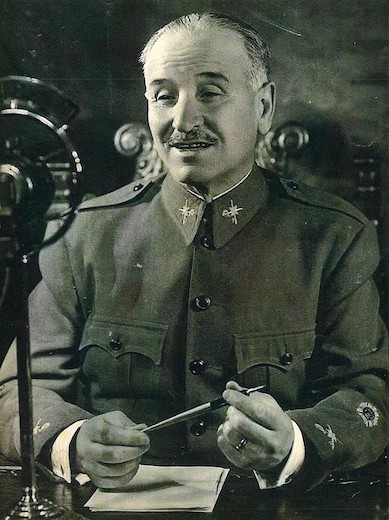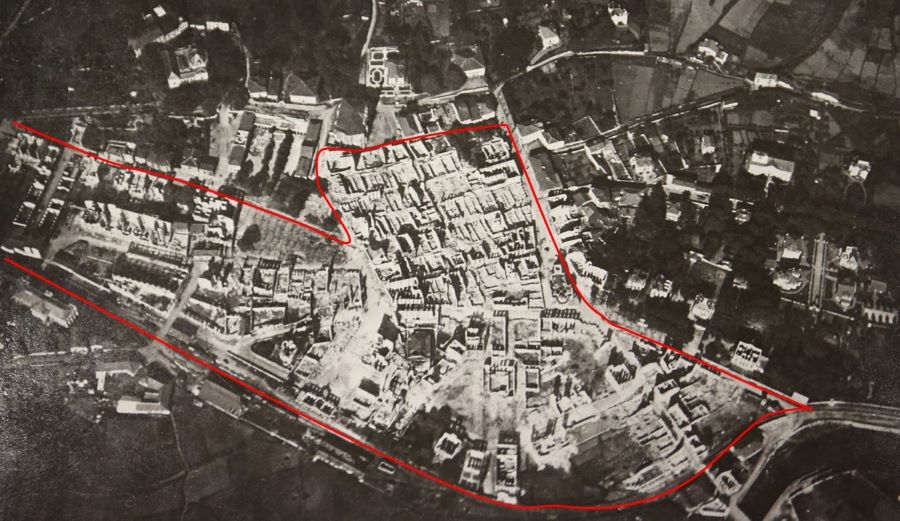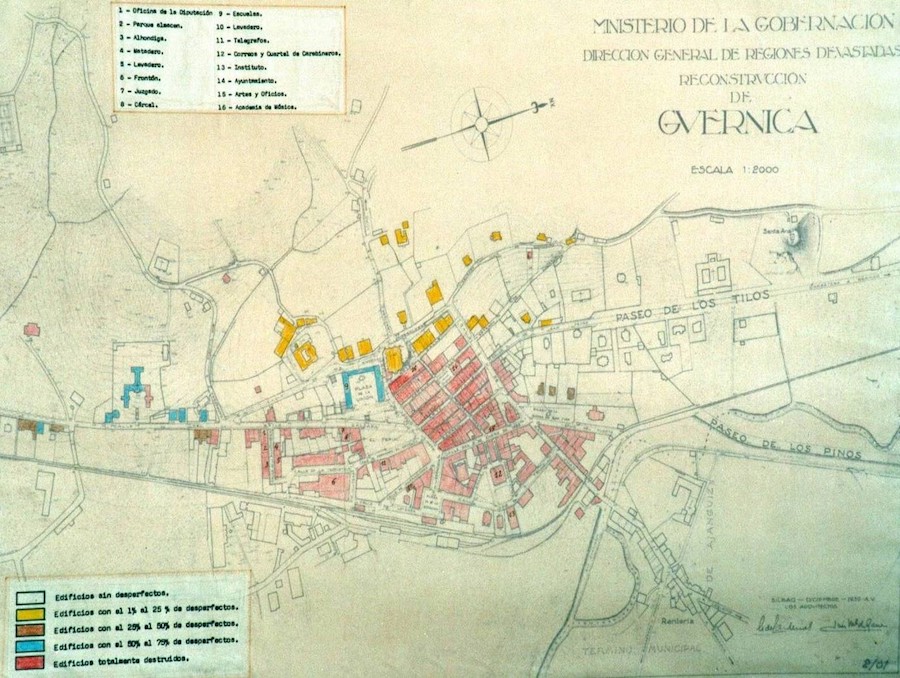At the end of August 1937, six Italian bombers Savoia-Marchetti SM.81 and 48 Italian fighters Fiat Cr.32 bombed and machine-gunned the last trenches southwest of Bilbao. 6,800 kilos of bombs were dropped with “excellent effect” against the Basque republican troops. This is the last bombardment on Basque soil of the War of 1936, where a total of 1,242 bombing operations were recorded between July 22, 1936, and the end of August 1937. 1,242 bombing operations represents more than 2,000 bombings, 24% of them episodes of terror bombing.
In August of 2022, we will commemorate the 85th anniversary of the end of such a devastating bombing campaign, but 2022 also marks the 85th anniversary of a lie. On April 27, 1937, before seven in the morning, Franco ordered the media to lie. Specifically, he ordered that all the media controlled by the Spanish rebel government immediately announce that 1) Gernika had never been bombed and, 2) that Gernika had been “completely destroyed by the fleeing Reds, with fire and dynamite”, following “the ferocious system of burning and destroying all urban centers before retreating”.

Franco’s order was transmitted to Luis A. Bolín, head of the Salamanca Press and Propaganda Office, and he poured it into all the media under the rebel government’s control. General Gonzalo Queipo de Llano from Radio Sevilla was one of the first and most energetic propagators of this version of events and under the title “Miente Agirre” (“Basque president Jose A. Agirre lies”) the news was spread all over the territory controlled by the rebels. The German and Italian regimes also echoed it, although in Germany it was conveniently preferred to accuse the Jews of burning Gernika.
They lied so much and so badly that the Marquis del Moral, coordinator of the Spanish rebel propaganda office in London, went personally to Salamanca to recommend the dismissal of Bolín, which Franco ordered immediately, in May 1937. The Duke of Alba also called for Franco’s attention, arguing that indeed he had to lie about Gernika, but that he had to do it well. He proposed that a report be written which, with the appearance of technical and neutral, be published in English and distributed in the United Kingdom.
That is the origin of the Herrán Report, a brochure that was published in London by Eyre & Spottiswoode in 1938 under the title Guernica; Being the Official Report of a Commission Appointed by the Spanish National Government to Investigate the Causes of the Destruction of Guernica on April 26-28, 1937. The authors of the Herrán Report concluded that “the destruction of Guernica was caused by fire”. That “the number of victims in Guernica on the 26th of April did not reach one hundred”, that “no signs are visible of the explosion of any aerial bombs within the town”, and that “the destruction of Guernica, therefore, cannot be attributed to German planes”.
It was the worst propaganda operation orchestrated by Franco, but it cannot be denied that it has survived time.
We have documented more than thirty lies about the bombing of Gernika[1], but four among them have been the most vigorously and persistently defended throughout these eight decades:
- Neither General Francisco Franco nor General Emilio Mola knew anything about the bombing of Gernika.
- Gernika was not destroyed by the rebel bombing but by a fire started by the Basque “reds”.
- It was not a terror bombing episode but a strategic bombing.
- The destruction was insignificant, and less than 300 lost their lives.
Some authors still keep repeating these lies, and their genealogy can be traced.
Some argue that after having used 20% of the rebel aviation at Franco’s disposal in the entire Iberian Peninsula on a single target for three and a half hours, neither Franco nor Mola knew anything about the bombing. It is even more strange when General Hugo Sperrle himself, head of the Condor Legion, and Wolfram von Richthofen, chief of staff of said legion, wrote that the attack had been an order “of the superior command” (aka, Franco) who was, according to article three of the General instructions for liaison with the aviation of November 17, 1936, the only one that could order aerial bombardments against urban areas. And it is even more strange, in the end, that there was not the slightest complaint, reprimand or censorship on the part of the Spanish command to the Germans. That it was Franco himself who issued the order to deny that Gernika had been bombed a few hours after the attack (when in theory he did not know what had happened…).
We have already said it, Franco lied and ordered the media to lie. Generals Mola and Colonel José Solchaga following his order lied too. 84 years later Division General Rafael Dávila Álvarez reproduced and amplified the caudillo’s order to lie at all costs in his recent book La Guerra en el norte. The strange notion that Franco was innocent has been vehemently defended by authors like Ricardo de la Cierva, Jaime del Burgo, José M. Martínez Bande, Vicente Talón, and Major General Jesús Salas. Now the grandson of General Fidel Dávila, the person who took over Bilbao in June 1937, joins them.
One of the last authors in defending that Gernika was destroyed by “the red firebrand” was Brian Crozier in his biography of Franco published in 1967. Crozier argued in his book that the attack against Gernika was a minor air raid operation and that the “reds” who systematically destroyed Gernika by setting it afire with gasoline and dynamite caused the real destruction of the city. “The truth is great and must prevail” wrote the author... Four years later, Jeffrey Hart published an article in the National Review on “The Guernica fraud” (1973) saying that the town was never bombed but destroyed by fire. Crozier republished his thesis in The Guardian on May 27, 1991. This thesis is based on the conclusions of the Herrán Report and has been subsequently reproduced by Jesús Salas and César Vidal—among others—who made the serious methodological error of using the Herrán Report, a pro-Franco propaganda libel, as an acceptable source of historical information.
Another great lie is to try to distort the nature of this attack by claiming that it was a “strategic bombardment” aimed at destroying the Errenteria bridge. One of the first defenders of this idea was Adolf Galland, a pilot of the Condor Legion, who pointed out that it was not a terror bombing but “an unfortunate miscalculation in the shot.” It is difficult to believe that the air command decided to drop between 31 and 46 tons of explosive and incendiary bombs and machine-gun the population of the city for three and a half hours to destroy a 19.5 meters long and 9.5 meters wide bridge. The “miscalculation” resulted in the total demolition of 85.22% of the buildings in Gernika and affected 99% of the city.

If after using 59 airplanes on some 10,000 defenseless civilians who were literally cornered in a space of 0.134 km2 (an irregular polygon of 340 meters x 700 meters), the death toll would have been about 300 people, there would not be aerial bombardments today. The key to bombing at war is that it destroys and kills more effectively, quickly, and, fundamentally, cheaply than other methods of conducting war. More than 2,000 people—mostly civilians—died as a result of the bombing of Gernika. This is the only valid conclusion from an epistemological perspective and the only one that we can reach if we use historical sources with minimal seriousness. Why “more than 2,000 people”? Because the Basque Government issued a register of 1,654 deaths as a result of this bombing. Moreover, the authorities warned that this figure was partial, since they did not have time to clear the town before it was occupied by the rebel troops three days later (Gernika was not completely cleared until the end of 1941 and the rebel authorities did not register any corpses under the debris). In addition, two direct witnesses, Jose Labauria, mayor of Gernika and Joxe Iturria, a Basque soldier who helped in the removal of corpses from the debris the day of the bombing, affirmed that between 450 and 500 people died in the Andra Mari refuge, whose bodies are logically among those who were never recovered. 1,654 plus 450 makes more than 2,000. There are no documents that support any figure above or below that, so that no other can be given.
The document signed by President Jose Antonio Agirre lists 2,965 deaths caused by the rebel bombings in April 1937 on Basque soil. All those authors who speak of less than 2,965 deaths in the month of April or less than 1,654 deaths in Gernika are simply omitting a record that no one has denied, because no one has proven that this document and the 39 testimonies that support it are false or exaggerated. On the contrary, in all cases (such as the bombing of the cities of Durango or Otxandio) the Basque Government fell short in calculating the death toll.
Noel Monks was one of the 39 direct witnesses who corroborated the figures of the Basque Government. He wrote what he “saw”: “In the good ‘I’ tradition of the day, I was the first correspondent to reach Guernica, and was immediately pressed into service by some Basque soldiers collecting charred bodies that the flames had passed over. Some of the soldiers were sobbing like children. There were flames and smoke and grit, and the smell of burning human flesh was nauseating. Houses were collapsing into the inferno.” Joining him were reporters Mathieu Corman, Christopher Holme, George Steer and Scott Watson. They all returned to Bilbao and wrote about what happened that same night. The next day, while they had breakfast, they listened to Radio Sevilla, from which Queipo de Llano was broadcasting. To his surprise, even from Berlin he denied that Gernika had been bombed. And, as Monks recalled in his memoirs, “Then came the last straw for me. We were sitting round a radio at the Presidencia listening to General de Llano make one of his vile broadcasts to the women of Madrid, telling them, in detail, what to expect from the Moors. Suddenly he switched to Guernica. ‘That Señor Monks,’ he croaked. ‘Don’t believe what he writes of Guernica. All the time he was with Franco’s forces he was drunk.” Everyone laughed but that turned into offense when Monks received a call from the London Daily Express asking him to return to Gernika and verify what he had seen the day before: “Later that day I was to get a bomb addressed to me, personally. So was Steer. So was Holme. It was in the form of a cable from my office: ‘Berlin denies Guernica bombing. Franco says he had no planes up yesterday owing fog. Quiepo de Llano [Franco’s foul-mouthed broadcasting general in Seville] says Reds dynamited Guernica during retreat. Please check up soonest.’ Please check up…! They tried to discredit us as liars,” Monks wrote.
They returned to Gernika and wrote their chronicles again. This is how Monks explained what he saw: “I was back at Guernica at day-break. I saw 600 bodies. Nurses, children, farmers, old women, girls, old men, babies. All dead, torn, and mutilated. Basque soldiers were getting the bodies from the wreckage, many of them weeping. I came to what had been an air-raid shelter. In it were the remains of fifty women and children. A bomb had dropped right through the house into the cellar. Does Franco expect the world to believe that fifty women and children fled into an air-raid shelter when their house was mined? Or trapped themselves below there while the house above them was set alight? I went back to Bilbao and wrote another story, just what I had seen. Just as I would have written it if it had been a Franco town in ruins.” Not only did he write this article, but he requested that it be published with a reproduction of the telegram in which Franco denied that the town had been bombed and he signed it with his handwritten signature.
In response to Queipo de Llano, Monks would later say that “Fact is, I’m a teetotaller. Have been all my life. Ask anyone who knows me. But don’t ask me who bombed Guernica. I might take to drink.”. And he signed: “Franco told the world there were none of his planes up that day, because of bad weather. I’m telling the world now that there were. I saw them. My two colleagues saw them. Six thousand inhabitants of Guernica saw them. And Monday, April 26th, was the sunniest day of all I spent on the Basque front. […] I was among the ruins of Guernica one hour after the raiders had done their work. I wandered all over them, as far as I was able: the whole town was in flames. I saw bodies in the fields spotted with machine-gun bullets. I interviewed twenty or thirty survivors. They all told the same tale. Those who could speak”.
We must write history from the historiographic sources that we have. There is no document that supports the figure of “a dozen” people dead in Gernika given by Ricardo De la Cierva, or that of 120 given by Jesús Salas Larrazabal, or that of around 300 given by Vicente Talón, James S. Corum and others. These are opinions, discredited opinions, but opinions. Noel Monks was neither a drunk nor a liar. He saw 600 bodies and claimed that the dead numbered in the thousands. He who does not believe his statement must prove that he lied: That is what turns an opinion into a historiographic criterion.
The lie about the fire of Gernika has a linear genealogy: Franco’s order was assumed by Queipo de Llano, Bolín and Joachim von Ribbentrop; Adolf Galland, Jeffrey Hart, De la Cierva, Salas Larrazabal and others have taken the baton decades later. Now the grandson of General Dávila joins this stream of thought in his own right. Those who think so will also be part of this illustrious and fallacious genealogy. Monks “saw” 600 bodies and wrote that the death toll was over 2,000 deaths. Those who defend a lower figure are indeed, like Queipo de Llano, calling him a liar.
We position ourselves with the version that historical documents and the testimonies of Monks and other admissible and trustworthy eyewitnesses have left us about what happened that afternoon in Gernika. We write from relevant archive material without omissions because history is written, not crafted.
History cannot serve to excuse or discuss responsibility for the atrocities committed by those who ordered or executed the bombing. But, fundamentally, neither can history be used to gratuitously reduce the number of victims caused by the rebels or to disguise the nature of their atrocities. Doing so is ethically and morally reprehensible.
[1] See, Xabier Irujo. Gernika : genealogy of a lie. Brighton; Chicago; Toronto: Sussex Academic Press, 2019. The Cañada Blanch/Sussex Academic studies series on contemporary Spain.
















